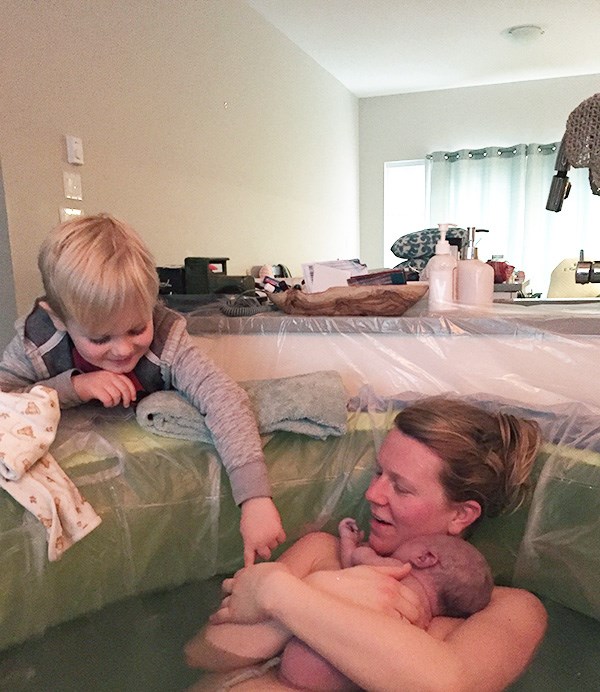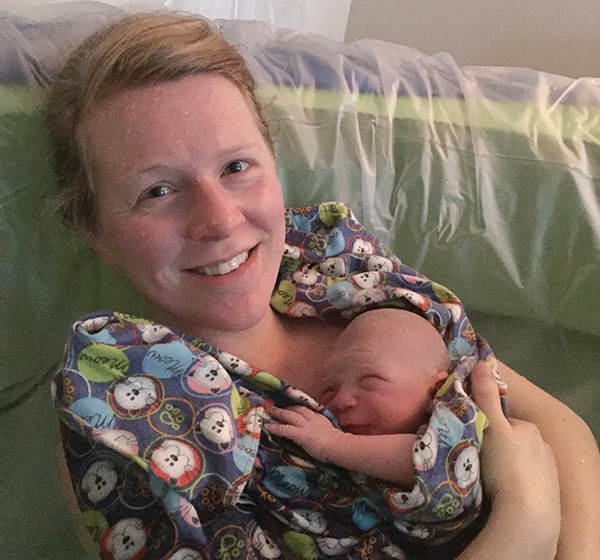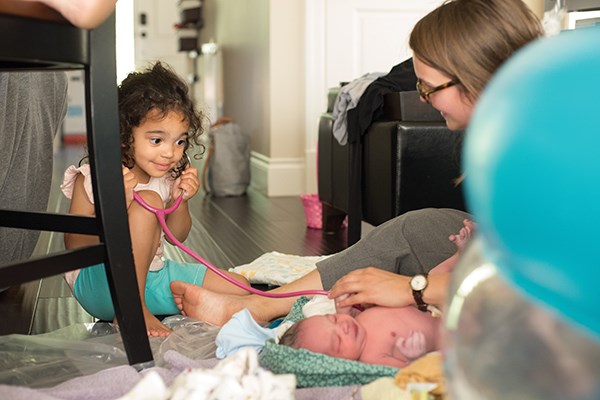Leaning over the inflatable birth pool, Ashleigh Fonseca’s five-year-old son, Sawyer, put his hand on his mom’s head as she prepared to deliver her baby.
The atmosphere in the living room of the Squamish family’s townhouse was serene. Fonseca relaxed in the pool as the fireplace flickered in the background and her midwife, doula and husband stood nearby to offer support.
Before the baby was born in the warm water, the 32-year-old mother rocked back and forth on an exercise ball and walked the length of the home, stopping occasionally to look out the window.
At one point, her midwife performed acupuncture, targeting points in her back and knees to help the baby get in an ideal position to relieve back labour pain.
“Within an hour after having him, we were sitting on the couch watching The Good Dinosaur with my five-year-old,” said Fonseca, a financial advisor, as she holds her two-month-old son, Nolan, in her arms.
The idea of delivering the baby in the comfort of her own home was appealing to Fonseca, along with her wishes to have an un-medicated birth and receive as few interventions as possible. She was also comforted by Squamish General Hospital being a five-minute drive away in case her midwife recommended transferring for additional care.
The team of four midwives at Roots Community Midwives, located on Tantalus Road, attend around 40 home births a year in Squamish.
They serve women in the whole Sea to Sky Corridor but only do home births closer to town, leading women from Whistler and other communities to travel to Squamish to give birth in the homes of friends and family or rent a hotel room.
Beth Ebers, a midwife in Squamish, said research shows that home birth is at least as safe as giving birth in the hospital, provided that the women have normal, healthy pregnancies, are looked after by a health-care provider trained in home birth and have a hospital nearby if backup medical attention is needed.
“Hospitals are the default place to give birth, and we’re taught they’re the safest and best place. In our culture, we have a lot of work to do to trust our bodies and trust birth,” said Ebers, who has seen home births steadily increase in Squamish since the midwifery practice opened six years ago.
“It’s about informed choice and we, as midwives, support our clients either way.”
For many women, the decrease in interventions, such as induction, electronic fetal monitoring, episiotomy, forceps delivery and caesarean section, is a main reason to have a home birth.
Fifteen per cent of women in the Vancouver Coastal Health region, which covers Squamish, had a midwife deliver their baby, according to a report by Perinatal Services BC that covers the period between April 2014 and March 2015. Of these births, around 15 per cent took place at home.
The report states home births account for around two per cent of the total births in the province, a small number that has been steadily growing since 1998, when B.C. legalized midwifery.
“For those having a home birth, the demographic is very diverse,” said Ebers, whose clients have included lawyers, doctors and a wide range of other professions.

Born in water
Kimberly Daniels’ two-year-old daughter kept sleeping as her brother was born in water at their Squamish home in the middle of the night.
“It’s good to be fully immersed in the pool. It helps with pain management and it’s relaxing to feel nearly weightless,” said Daniels, who is also a doula in Squamish.
Around 40 per cent of women having home births in Squamish give birth in water, and the majority spend part of their labour in water.
In addition to supporting women during pregnancy and labour, Daniels also rents and lends equipment used during home births, including birth pools and Elle Tens units, a machine used during labour to decrease pain by sending gentle pulses to the nerves through electrode pads placed on the back. “It’s not about the hospital being a bad place, because it isn’t. It’s about where the mom feels most safe and comfortable,” said Daniels.
Katia Grondin, a Squamish-based photographer who runs Katia Grondin Photography, has shot nine births, seven of which have been at home.
“In order to successfully shoot a home birth, I make myself a fly on the wall, so to speak. Interactions with the birthing woman are extremely minimal…. The energy in a birth room can have a huge effect on the labouring mother, so it is incredibly important for me to blend into my surroundings as much as possible,” said Grondin, who took photos while her sister, Micheline Walkey, gave birth to her daughter at home in the water last March. Walkey is a doula in Squamish.
“My older daughter was there for the birth,” said Walkey, “and Katia captured some amazing shots of her supporting me and seeing her sister for the first time.”
Home births still rare
For many mothers giving birth at home, safety is also a top priority. Around 24 per cent of women in B.C. transfer to the hospital while in labour as a precautionary measure to ensure both mother and baby are safe, according to the Perinatal Services BC report.
Approximately five per cent of transfers are for emergency reasons.
Like Fonseca, who transferred with her first son because he had meconium in the water, making it potentially difficult to breathe, Daniels also transferred to the hospital with her first birth as a precaution.
Midwives come equipped with the same tools that are found in a hospital delivery room – with the exception of epidurals – including fetal dopplers, stethoscopes, blood pressure cuffs, oxygen tanks, bags and masks for resuscitation, drugs to stop hemorrhaging, IV bags to treat bleeding and medication if stitches are required.
“I read a couple books, and I learned that in the case of an emergency c-section, you will be at the hospital in the time it takes the doctors to get there,” said Abby Andrews, who had her two daughters at home in Squamish.
Andrews became interested in home birth after learning about the experience from a friend who had one in North Vancouver. She also took a hypnobirthing class, a mind-body relaxation technique used during unmedicated births.
Still, around 98 per cent of women in Canada choose to give birth in the hospital, often because of the additional medical care that is provided, such as more staff on hand, including doctors and nurses, and the proximity to the operating room if anything goes wrong.
In addition, women who have certain complications during their pregnancies are advised to give birth at the hospital where they can receive extra attention.
Shannon Prasad, whose daughter was Squamish’s new year’s baby – the first birth of 2016 – did her own research and went to an information evening held by Roots Community Midwives before deciding on a home birth.
Her husband was supportive after hearing what the research revealed.
“My midwives gave me a list of things to buy that I got from Walmart and the dollar store,” said the first-time parent. Her list included many of the things usually provided by the hospital, such as towels, garbage bags, thermometer, extra sheets, newborn diapers and food for the care providers.
Echoing the other women, Laura Rolandi, who is from Squamish but gave birth at her parents’ house in Furry Creek, said she would have a home birth again, provided she had another healthy pregnancy.
“I wanted to know who would be there at the time, and I liked that I had control over this,” said Rolandi, who had her son in the middle of the night in September.
She had planned to have a water birth but had to get out when she became too relaxed and her contractions stopped.
“I got to be in my comfy bed right after, and I had amazing support.”




